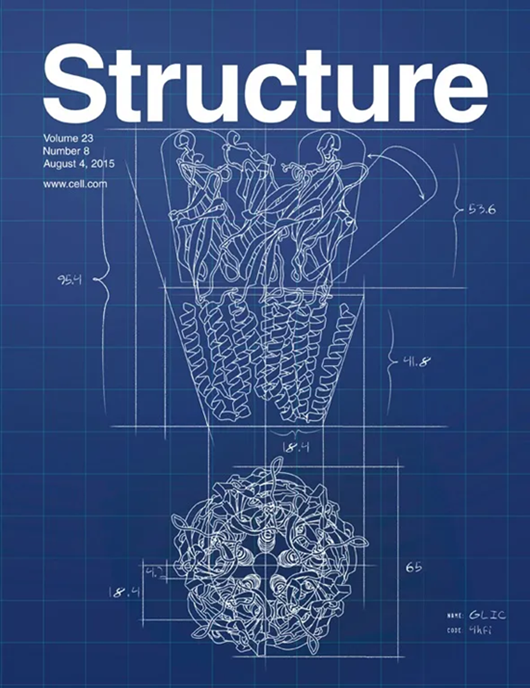蛇毒样酶活性位点变异和β-8环相互作用的结构见解
IF 4.3
2区 生物学
Q2 BIOCHEMISTRY & MOLECULAR BIOLOGY
引用次数: 0
摘要
Viperin和Viperin样酶(VLEs)是自由基SAM超家族的成员,可以对三磷酸核苷进行自由基介导的脱水,生成3 ' -脱氧-3 ',4 ' -二脱氢核苷三磷酸(ddhNTPs)。有趣的是,viperin和VLEs表现出物种依赖的底物选择性。一些真菌物种有第二个VLE,而大多数毒蛇和VLE含有NΦHX4CX3CX2CF基序,这些二级VLE被组氨酸到苯丙氨酸的取代,一个NΦFX4CX3CX2CF基序(NΦF)催化阻碍。在此,我们利用生物信息学、酶学和x射线晶体学的结合来证明NΦF VLEs可能利用CTP作为底物。基于这些观察结果,我们证明了TvVip1中的β-8环可以与来自CTP选择性蝰蛇(Mus musculus)的β-8环一起工程,以“交换”从UTP到CTP的底物选择性。这些结果提供了对VLEs所表现出的底物选择性的决定因素的深入了解,并介绍了工程蝰蛇蛋白和VLEs形成替代ddhNTPs的潜在途径。本文章由计算机程序翻译,如有差异,请以英文原文为准。

Structural insights from active site variants and β-8 loop interactions in viperin-like enzymes
Viperin and viperin-like enzymes (VLEs) are members of the radical SAM superfamily that perform radical-mediated dehydrations on nucleoside triphosphates to yield 3′-deoxy-3′,4′-didehydronucleoside triphosphates (ddhNTPs). Interestingly, viperin and VLEs demonstrate species-dependent substrate selectivity. Some fungal species have a second VLE and, while most viperin and VLEs contain an NΦHX4CX3CX2CF motif, these secondary VLEs are catalytically hindered by a histidine to phenylalanine substitution, an NΦFX4CX3CX2CF motif (NΦF). Herein, we utilize a combination of bioinformatics, enzymology, and X-ray crystallography to demonstrate that NΦF VLEs likely utilize CTP as a substrate. Based on these observations, we demonstrate that the β-8 loop in TvVip1 can be engineered with the β-8 loop from a CTP-selective viperin (Mus musculus) to “swap” substrate selectivity from UTP to CTP. These results provide insight into the determinants of substrate selectivity exhibited by VLEs and introduce a potential route for engineering viperin and VLEs to form alternative ddhNTPs.
求助全文
通过发布文献求助,成功后即可免费获取论文全文。
去求助
来源期刊

Structure
生物-生化与分子生物学
CiteScore
8.90
自引率
1.80%
发文量
155
审稿时长
3-8 weeks
期刊介绍:
Structure aims to publish papers of exceptional interest in the field of structural biology. The journal strives to be essential reading for structural biologists, as well as biologists and biochemists that are interested in macromolecular structure and function. Structure strongly encourages the submission of manuscripts that present structural and molecular insights into biological function and mechanism. Other reports that address fundamental questions in structural biology, such as structure-based examinations of protein evolution, folding, and/or design, will also be considered. We will consider the application of any method, experimental or computational, at high or low resolution, to conduct structural investigations, as long as the method is appropriate for the biological, functional, and mechanistic question(s) being addressed. Likewise, reports describing single-molecule analysis of biological mechanisms are welcome.
In general, the editors encourage submission of experimental structural studies that are enriched by an analysis of structure-activity relationships and will not consider studies that solely report structural information unless the structure or analysis is of exceptional and broad interest. Studies reporting only homology models, de novo models, or molecular dynamics simulations are also discouraged unless the models are informed by or validated by novel experimental data; rationalization of a large body of existing experimental evidence and making testable predictions based on a model or simulation is often not considered sufficient.
 求助内容:
求助内容: 应助结果提醒方式:
应助结果提醒方式:


